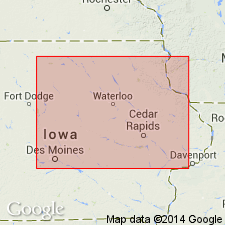
- Usage in publication:
-
- Cou Falls Member
- Modifications:
-
- Named
- Dominant lithology:
-
- Limestone
- AAPG geologic province:
-
- Iowa shelf
- Lincoln anticline
- Wisconsin arch
- Illinois basin
Summary:
Named as basal member, Coralville Formation (rank raised), 1 of 4 formations of Cedar Valley Group (revised). Type locality: Mid River Marina Quarry, 3.5 km southeast of village of Cou Falls, NW NE SE sec 27, T81N, R7W, Johnson Co, IA. Recognized in east-central and southeast IA (Iowa shelf) and adjacent northeast MO (Lincoln anticline) and western IL (Wisconsin arch, Illinois basin). Contact with underlying Rapid Member (named), Little Cedar Formation (named), Cedar Valley Group sharp; calcarenites of Cou Falls infill vertical burrows that penetrated locally up to 30 cm on prominent discontinuity surface separating Cou Falls from Rapid. Overlain by Andalusia Member (named), Lithograph City Formation (named), upper formation Cedar Valley Group. Disconformably overlies Hinkle Member (named), Little Cedar Formation along south border. Replaced to north and west by Gizzard Creek Member (named), Coralville. Is 3.8 m thick in type; varies between 3.5 and 11 m. Consists mostly of limestone--a fossiliferous fine-grained calcarenite with coral and stromatoporoid biostromes. Thin shaly and carbonaceous partings in lower half. Graphic sections. Nomenclature chart. Fossils (less diverse upwards): conodonts of Upper SUBTERMINUS fauna, rugosans, favositids, stromatoporoids, brachiopods, echinoderm debris, bryozoans, trilobites, gastropods, etc. Lower part transgressive; upper part open marine subtidal. Of Middle Devonian, late Givetian age.
Source: GNU records (USGS DDS-6; Denver GNULEX).
For more information, please contact Nancy Stamm, Geologic Names Committee Secretary.
Asterisk (*) indicates published by U.S. Geological Survey authors.
"No current usage" (†) implies that a name has been abandoned or has fallen into disuse. Former usage and, if known, replacement name given in parentheses ( ).
Slash (/) indicates name conflicts with nomenclatural guidelines (CSN, 1933; ACSN, 1961, 1970; NACSN, 1983, 2005, 2021). May be explained within brackets ([ ]).

